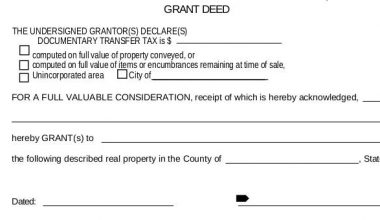If you’re looking for a new house but are having problems getting a loan preapproval, owner financing is an option that can help you achieve your goal of owning. Though not all sellers will be willing or able to provide direct financing to the buyer, it can be a great method to buy a home while also making the closing process go more smoothly. Owner-financed homes, on the other hand, can be complicated and require a written agreement, so it’s critical to understand the procedure before signing on the signed line. We’ll go through how owner financing works, how it might benefit you as a buyer or seller, and how to structure a deal with an owner.
What Is Owner Financed Homes?
A financial agreement between a home seller and a home buyer that replaces a standard bank-subsidized mortgage with a direct payment plan between the seller and the buyer is known as owner financing. Owner financing works similarly to a traditional bank loan in that the seller finances the home and the buyer repays the seller over time according to the conditions of the loan.
This process will begin with a substantial down payment on the house and a monthly loan payback amount plus interest. Owner financing is typically more expensive than regular lending from a bank or other financial institution. It is, nevertheless, a realistic option for house buyers who are unable to obtain financing from a regular lender.
Overview
A buyer may be eager to buy a home, but the seller will not budge from the asking price of $350,000. The buyer is willing to pay that amount and can put down 20% of the purchase price—$70,000 from the sale of their previous property. They’d need $280,000 in financing, but they can only get approved for a typical mortgage of $250,000.
The seller may agree to lend them $30,000 to cover the gap, or they may agree to finance the total of $280,000. In either situation, the buyer would pay the seller monthly for the loan’s principal and interest. When the buyer and seller are family or friends or are connected in some other way outside of the transaction, these loans are rather typical.
Owner-Financed Homes Example
Let’s imagine a seller lists a home for $200,000 on the market. Because he is self-employed, a potential buyer is unable to obtain traditional financing. He makes a full-price bid and asks for 15 percent ($30,000) of owner financing.
The seller, who has no mortgage on the house, accepts the offer and creates a mortgage note requiring the buyer to repay her over ten years at 8% interest with a balloon payment at the end. The buyer pays the seller $1,247.40 per month, and the seller receives an 8% return, totaling $224,532 over the course of ten years.
How Do Owner-Financed Homes Work?
Here is a general overview of how the owner-financing process works.
#1. The buyer and seller agree on financing terms
When the buyer and seller sign a promissory note, they agree on the terms of the loan. This covers parameters such as interest rates, amortization schedules (the period for making regular mortgage payments), and the loan’s payoff deadline.
#2. The buyer pays a down payment
After both parties have agreed on financing terms, the buyer makes a down payment on the property to secure the purchase. When compared to a standard mortgage lender, this upfront payment is often a bigger percentage of the purchase price. This is because given the financial risk they are taking, the owner will want as much security as feasible.
#3. The buyer makes monthly payments on the loan
In most cases, the buyer will pay off the remaining balance of the mortgage in monthly installments. This includes direct property tax and insurance payments, which are often included in a regular mortgage but are not with owner financing.
#4. The buyer pays off their loan
The buyer will normally be required to pay a balloon payment or a lump-sum payment at the conclusion of the loan period to cover any leftover costs. If the buyer is unable to make the balloon payment, they may seek additional financing to pay the seller, taking out a new loan to cover the remaining balance of the home’s price plus interest.
4 Types of Owner Financied homes
A formal contract should be used to memorialize an owner-financing agreement. An owner financing arrangement can be structured in a variety of ways, including the ones listed below.
#1. Promissory note or mortgage
His idea is similar to a standard mortgage deed, in which the buyer signs a document confirming that the lender has a security interest in their home until the loan is repaid. The buyer receives the title and the mortgage is with the local government in this scenario.
#2. Deed of trust
This is a different type of promissory note that looks like a mortgage deed. The ownership of the home is by a third-party trustee in a deed of trust. The title is to the buyer once the loan terms have been met.
#3. Contract for deed
The buyer does not receive the deed and title to the property until the loan is in full, according to this agreement. The seller keeps the property deed and title until that time.
#4. Lease-purchase agreement
The buyer of a lease-purchase arrangement, also known as a rent-to-own deal. Rents the property for a set amount of time before agreeing to the final conditions of purchase. Any rent paid during the lease period goes toward the selling of the home if the buyer decides to buy at the end of the lease period.
5 Advantages of Owner-Financed homes
For both sellers and purchasers, owner financing has significant advantages over standard finance models.
#1. Fewer hurdles to financing for buyers
For purchasers, owner financing may allow you to acquire finance that you would not otherwise be able to receive. If you have inconsistent income or a low credit score. For example, obtaining a mortgage loan from a traditional lender may be more difficult, making owner financing a potential choice.
#2. Shorter due diligence period
The due diligence period for home assessments and inspections might be in owner financing arrangements. The buyer, for example, does not require a home evaluation in order to obtain financing from their bank. This means you’ll be able to conclude the sale sooner, which will benefit both the buyer and the seller.
#3. No minimum down payment
In contrast to a Federal Housing Administration (FHA) loan, there is no government-mandated minimum down payment with owner financing. This means that if a seller agrees, a buyer may be able to negotiate a reduced down payment.
#4. The closing costs are lower
Owner financing allows both sellers and purchasers to save money on closing costs including inspections, appraisals, and bank fees.
#5. Potentially better investment returns
For sellers, owner financing can offer long-term consistent cash flow on a property from the high-interest rate on the loan.
4 Disadvantages of Owner-Financed homes
Without the security of a standard mortgage loan. There are various dangers that a buyer or seller may face when using owner financing.
#1. Higher cost for buyers
For purchasers, owner financing usually entails larger down payments and interest rates. Resulting in a greater overall cost of the home than with a regular mortgage.
#2. High balloon payments
Buyers may receive a big lump sum payment at the conclusion of their loan term if the owner finance agreement contains a balloon payment clause.
#3. Potentially high risk for sellers
Homeowners who finance their sold home assume the risk of their buyer defaulting on their payments. If the buyer defaults on the loan, the seller is also liable and may be to file for foreclosure.
#4. Existing mortgage issues
There may be existing liens that complicate the loan repayment procedure if the seller already has a mortgage on the property they are selling. If the seller relies on the buyer to make their mortgage payments and the buyer defaults. The bank can foreclose on the house, putting both parties in a bad situation.
Is it Risky to Use Owner Financing?
The acquisition of a property through owner financing is a secure method of financing if both the buyer and the seller take the necessary procedures to safeguard their respective financial interests. The terms of the financing should, first and foremost, be properly spelled out in a written agreement that, preferably, should have been prepared by a certified legal professional.
And despite the fact that buyer financing eliminates the requirement for a lender-mandated appraisal and inspection, purchasers should still carefully consider taking measures to guarantee that the purchase price is reasonable. In a similar vein, sellers are not required to perform a credit check on potential buyers before agreeing to finance a deal. However, this is a good strategy to lessen the risks associated with owner financing and to increase the possibility that a buyer would make their payments on time.
Who Pays Property Taxes on an Owner-Financed Home?
When negotiating with a conventional mortgage lender, it is common practice to incorporate the payment for property taxes and insurance premiums into the monthly mortgage payment. When using owner financing, the borrower will normally pay their taxes and insurance premiums directly to the applicable government agency and insurance firm respectively. However, it is essential to note that purchasers and vendors can use the owner-financing agreement to choose how these payments should be processed.
What if the Buyer Defaults?
If a buyer defaults on owner financing, the type of agreement that was made between the buyer and seller will determine the repercussions as well as the seller’s ability to seek relief. If the transaction was structured as a lease option, for instance, the seller is required to commence eviction procedures in order to remove the non-paying buyer from the property. With a sale that is broken up into installments or a contract for a deed, the rules of the state can vary, and the seller may be required to foreclose on the buyer.
Because of this, sellers should utilize the financing agreement as a means of protecting themselves against unknowns and establishing clear expectations for the buyer. This may include providing specifics regarding what constitutes a late payment, whether there is a grace period, and what occurs in the event that the borrower defaults on the loan.
How to Structure a Seller Financing Deal
A written document containing the specifics of the deal should always be in an owner-financing agreement between buyer and seller. However, there are a few other approaches you can take, and the ideal one for you will depend on your individual needs and circumstances. A seller-financed deal can be structured in three ways:
#1. Use a Promissory Note and Mortgage or Deed of Trust
If you’re familiar with typical mortgages, you’ll recognize this model. A promissory note specifies terms such as the loan amount, interest rate, and amortization schedule, and it is by both the buyer and the seller. The house serves as collateral for the loan, and the buyer’s name appears on the title. The loan is then with the local government.
#2. Draft a Contract for Deed
A contract for deed, also known as an installment sale or land contract, is when a buyer does not obtain the deed to an owner-financed property until the final loan payment is made. Alternatively, if the buyer refinances the debt with another lender and pays the seller in full, the buyer gains title.
#3. Create a Lease-purchase Agreement
A seller leases a property to a buyer who has the option to buy it for a specified price. Also known as the rent-to-own or lease option. The buyer pays rent and then has the opportunity to buy the property or forfeit his lease option at the conclusion of the lease term. Rent during the leasing time is to the purchase price if he decides to buy the property.
We recommend consulting with a competent attorney who will create the relevant documentation in your best interests because owner financing can be complicated.
How Does Owner Finance Work in Texas on a House?
When a homeowner in Texas provides finance for the purchase of their property, this means that the seller assumes the function of the lender, which is a more conventional real estate transaction that would be played by a financial institution. However, rather than handing over cash to the buyer, the seller offers credit in the amount of the price that was agreed upon for the sale, less the amount that the buyer will put down as a deposit.
How Does Owner Financing Affect Taxes?
You are able to spread out the realization of your gain over a number of years if you sell the property with owner financing and report the transaction as an installment sale. You pay a considerably smaller amount of taxes on the capital gains throughout the year when you get the income, as opposed to paying the full amount of taxes on the profits all in the first year. This enables you to disperse the impact of the tax hit across a number of years.
How Does Owner Finance Work in Texas?
When a homeowner in Texas provides finance for the purchase of their property, this means that the seller assumes the function of the lender, which is a more conventional real estate transaction that would be played by a financial institution. However, rather than handing over cash to the buyer, the seller offers credit in the amount of the price that was agreed upon for the sale, less the amount that the buyer will put down as a deposit.
Requirements for Owner-Financed Homes
A promissory note should be to ease an owner-financing transaction. The promissory note describes the details of the agreement, including the interest rate, repayment timeline, and default penalties, among other things. To safeguard oneself against default, the owner usually maintains the property title until all payments have been made.
While some do-it-yourself transactions can be handled entirely by the owner. Hiring an attorney to verify that all of the bases are usually a good idea. Paying for a title search can also help to ensure that the owner/seller is in a position to sell the property and that they will eventually release the title in exchange for financing some or all of the transaction.
FAQs
Is owner financing same as rent to own?
A crucial difference between these two ways of buying a house is the timing of when the home changes hands. In the case of a seller being the lender, the change of ownership takes place right away. With rent-to-own, the renter does not become the owner until a time that may be years down the road.
Who pays property taxes on owner financing?
When working with a traditional mortgage lender, property taxes and insurance premiums are often rolled into the monthly mortgage payment. With owner financing, the borrower typically pays taxes directly to the relevant agency and insurance premiums to their insurance company.
Does owner financing go on your credit?
Owner-financed mortgages typically aren’t reported to any of the credit bureaus, so the info won’t end up in your credit history.
Can I seller financed if I have a mortgage?
Seller-carried financing on mortgaged homes can be done, though sellers should structure their home sales carefully. While mortgage lenders might not pay attention to their mortgage loans if they’re paid on time, they notice when payments are missed.






